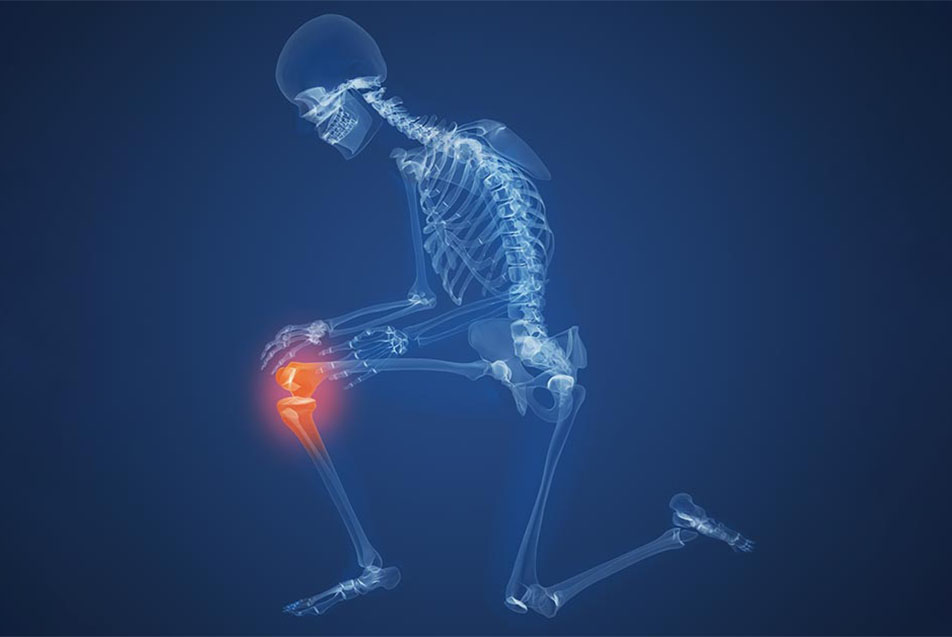Considering a total knee replacement? Matthew Grothaus, MD, PPG – Orthopedic Surgery, who sees patients at both Parkview Noble Hospital and Parkview LaGrange Hospital, talks to us about what is involved in the procedure, who are the best candidates and how you can set yourself up for success after surgery.
What is a knee replacement?
A knee replacement (also called knee arthroplasty) might be more accurately termed a knee "resurfacing", because only the surface of the bones are actually replaced.
There are four basic steps to a knee replacement procedure:
- Prepare the bone. The damaged cartilage surfaces at the ends of the femur and tibia are removed along with a small amount of underlying bone.
- Position the metal implants. The removed cartilage and bone is replaced with metal components that recreate the surface of the joint. These metal parts may be cemented or "press-fit" into the bone.
- Resurface the patella. The undersurface of the patella (kneecap) is cut and resurfaced with a plastic button. Some surgeons do not resurface the patella, depending upon the case.
- Insert a spacer. A medical-grade plastic spacer is inserted between the metal components to create a smooth gliding surface.

Who needs this procedure?
The most common cause of chronic knee pain and disability is arthritis. Although there are many types of arthritis, most knee pain is caused by three types: osteoarthritis, rheumatoid arthritis and post-traumatic arthritis.
We recommend the procedure if a patient is experiencing …
- Severe knee pain or stiffness that limits their everyday activities, including walking, climbing stairs, and getting in and out of chairs. They may find it hard to walk more than a few blocks without significant pain and they may need to use a cane or walker.
- Moderate or severe knee pain while resting, either day or night.
- Chronic knee inflammation and swelling that does not improve with rest or medications.
- Knee deformity — a bowing in or out of the knee.
- Failure to substantially improve with other treatments such as anti-inflammatory medications, cortisone injections, lubricating injections, physical therapy or other surgeries
Are you a candidate?
There are no absolute age or weight restrictions for total knee replacement surgery. Recommendations for surgery are based on a patient's pain and disability. Most patients who undergo total knee replacement are age 50 to 80, but orthopedic surgeons evaluate patients individually. Total knee replacements have been performed successfully at all ages, from the young teenager with juvenile arthritis to the elderly patient with degenerative arthritis.

Orthopedic evaluation.
An evaluation with an orthopedic surgeon consists of several components:
- A medical history. An orthopedic surgeon will gather information about the patient’s general health and ask about the extent of their knee pain and ability to function.
- A physical examination. This will assess knee motion, stability, strength and overall leg alignment.
- X-rays. These images help to determine the extent of damage and deformity in the knee.
- Other tests. Occasionally blood tests or advanced imaging such as a magnetic resonance imaging (MRI) scan, may be needed to determine the condition of the bone and soft tissues of the knee.
The surgeon will review the results of the patient’s evaluation and discuss whether total knee replacement is the best method to relieve pain and improve their function. Other treatment options — including medications, injections, physical therapy, or other types of surgery — will also be considered and discussed. In addition, there will be discussion of the potential risks and complications of total knee replacement, including those related to the surgery itself and those that can occur over time after your surgery.
Realistic expectations.
An important factor in deciding whether to have total knee replacement surgery is understanding what the procedure can and cannot do. More than 90 percent of people who have total knee replacement surgery experience a dramatic reduction of knee pain and a significant improvement in the ability to perform common activities of daily living.
With normal use and activity, every knee replacement implant begins to wear in its plastic spacer. Excessive activity or weight may speed up this normal wear and may cause the knee replacement to loosen and become painful. Therefore, most surgeons advise against high-impact activities such as running, jogging, jumping, or other high-impact sports for the rest of your life after surgery.
Realistic activities following total knee replacement include unlimited walking, swimming, golf, driving, light hiking, biking, ballroom dancing, and other low-impact sports. With appropriate activity modification, knee replacements can last for many years

Possible complications.
The complication rate following total knee replacement is low. Serious complications, such as a knee joint infection, occur in fewer than 2 percent of patients. Major medical complications such as heart attack or stroke occur even less frequently. Chronic illnesses may increase the potential for complications. Although uncommon, when these complications occur, they can prolong or limit full recovery.
- Infection. Infection may occur in the wound or deep around the prosthesis. It may happen while in the hospital or after the patient goes home. It may even occur years later. Minor infections in the wound area are generally treated with antibiotics. Major or deep infections may require more surgery and removal of the prosthesis. Any infection in the body can spread to the joint replacement.
- Blood clots. Blood clots in the leg veins are one of the most common complications of knee replacement surgery. These clots can be life-threatening if they break free and travel to the patient’s lungs. The orthopedic surgeon will outline a prevention program, which may include periodic elevation of the legs, lower leg exercises to increase circulation, support stockings and medication to thin the patient’s blood.
- Implant problems. Although implant designs and materials, as well as surgical techniques, continue to advance, implant surfaces may wear down and the components may loosen. Additionally, although an average of 115° of motion is generally anticipated after surgery, scarring of the knee can occasionally occur, and motion may be more limited, particularly in patients with limited motion before surgery.
- Continued pain. A small number of patients continue to have pain after a knee replacement. This complication is rare, however, and the vast majority of patients experience excellent pain relief following knee replacement.
- Neurovascular injury. While rare, injury to the nerves or blood vessels around the knee can occur during surgery.
Preparing for recovery at home after surgery.
Several modifications can make the patient’s home easier to navigate during recovery. The following items may help with daily activities:
- Safety bars or a secure handrail in your shower or bath
- Secure handrails along your stairways
- A stable chair for early recovery with a firm seat cushion (and a height of 18 to 20 inches), a firm back, two arms, and a footstool for intermittent leg elevation
- A toilet seat riser with arms, if the patient has a low toilet
- A stable shower bench or chair for bathing
- Removing all loose carpets and cords
- A temporary living space on the same floor because walking up or down stairs will be more difficult during early recovery
Social planning.
Although the patient will be able to walk on crutches or a walker soon after surgery, they will need help for several weeks with such tasks as cooking, shopping, bathing, and doing laundry. If a patient lives alone, their orthopedic surgeon's office, a social worker, or a discharge planner at the hospital can help make advance arrangements to have someone assist them at home. They also help arrange for a short stay in an extended care facility during recovery, if that’s a better option.

Pain management.
After surgery, the patient will feel some pain. This is a natural part of the healing process. Doctors and nurses will work to reduce pain, which can help the patient recover from surgery faster.
Medications are often prescribed for short-term pain relief after surgery. Many types of medicines are available to help manage pain, including opioids, non-steroidal anti-inflammatory drugs (NSAIDs), and local anesthetics. The doctor may use a combination of these medications to improve pain relief, as well as minimize the need for opioids. Be aware that although opioids help relieve pain after surgery, they are a narcotic and can be addictive. Opioid dependency and overdose has become a critical public health issue in the U.S. It is important to use opioids only as directed by a physician. As soon as pain begins to improve, stop taking opioids. Talk to your doctor if pain has not begun to improve within a few days of surgery.
How your new knee is different.
Improvement of knee motion is a goal of total knee replacement, but restoration of full motion is uncommon. The motion of a knee replacement after surgery can be predicted by the range of motion the patient had before surgery. Most patients can expect to be able to almost fully straighten the replaced knee and to bend the knee sufficiently to climb stairs and get in and out of a car. Kneeling is sometimes uncomfortable, but it is not harmful.
Most people feel some numbness in the skin around their incision. They also may feel some stiffness, particularly with excessive bending activities. Most people also feel or hear some clicking of the metal and plastic with knee bending or walking. This is a normal. These differences often diminish with time and most patients find them to be tolerable when compared with the pain and limited function they experienced prior to surgery. A new knee may activate metal detectors required for security in airports and some buildings. Tell the security agent about your knee replacement if the alarm is activated.
Protecting your knee replacement.
After surgery, patients should do the following:
- Participate in regular light exercise programs to maintain proper strength and mobility of the new knee.
- Take special precautions to avoid falls and injuries.
- Make sure their dentist knows that they had a knee replacement. Patients should talk with their orthopedic surgeon about whether they need to take antibiotics prior to dental procedures.
- See their orthopedic surgeon periodically for a routine follow-up examination and x-rays, usually once a year.




